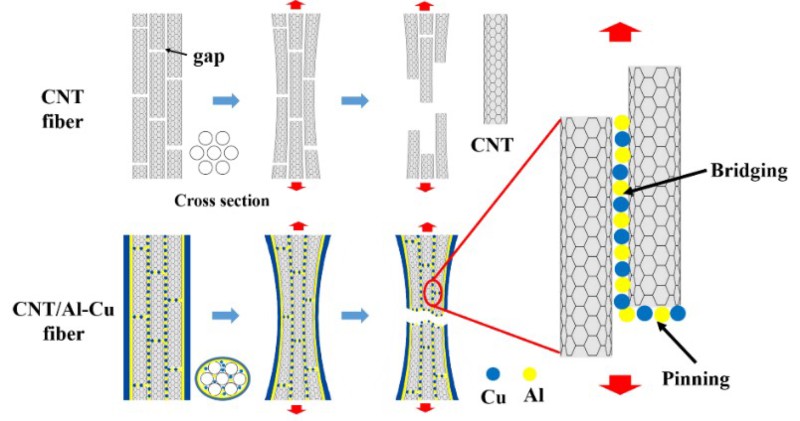With the miniaturization, intelligence and complicated application circumstances of electronical devices, common metal conductorsfail tosatisfy the development of electronical devices. Research and development of next-generation conductors have become one of the goals of researchers. Carbon nanotubes are the most promising next-generation conductorsdue to their excellent electrical conductivity, corrosion resistance, low density, and mechanical strength. However, owing to the weak van der Waals force between carbon nanotubes and the obvious electron and phonon scattering, the electrical and mechanical properties are greatly deteriorated when carbon nanotubes form a macro structure (such as carbon nanotube fibers and thin films). At present, researchers mainly improve the electrical conductivity by depositing metal on the surface of the carbon nanotube macro structure, but this method reduces the mechanical strength of the composite material.
To solve this problem, Prof. Xiangkang Meng's research group of College of Engineering and Applied Science of our school deposited an ultra-thin aluminum-copper composite film on the surface of carbon nanotube fibers through the magnetron sputtering process. Annealing and densification treatment were performed to diffuse metal intothe carbon nanotube fibers to form nanoparticles with the intention of reducing the contact resistance between the carbon nanotubes, and the electrical conductivity of the composite material was significantly improved. During tensile deformation, the particles distributed between the carbon nanotubes acted as a "bridge", and the particles distributed at the top will played a "pinning" role. Those two types of nanoparticles increased the sliding resistance between the carbon nanotubes , which significantly improved the tensile strength and elastic modulus of the composite. This structure realized the simultaneous increase of the electrical conductivity and strength of the carbon nanotube metal composite material, and obtainedcarbon nanotube/aluminum-copper nanocomposites with ultra-high strength (6.6 GPa), elastic modulus (500 GPa) and electrical conductivity (1.8 * 107 S / m).

Carbon nanotube / aluminum-copper composite fiber morphology and microstructure, conductivity vs strength relationship and uniaxial tensile strengthening mechanism
This work provides new ideas for the design of carbon nanotube composite materials and promotes the development of the preparation technique of carbon nanotube composite materials. The manuscript titled as Ultrastrong and Stiff Carbon Nanotube/Aluminum−Copper Nanocomposite via Enhancing Friction between Carbon Nanotubes is published on the top nano journal Naono Letters(DOI: 10.1021/acs.nanolett.9b02332). The affiliations of the first and corresponding authors are both Nanjing University. PhD student Genjie Wang of College of Engineering and Applied Science is the first author. Associate researcher Zhenhua Cao and Prof. Xiangkang Meng are the co-corresponding authors.
(Source:NJU news website)

